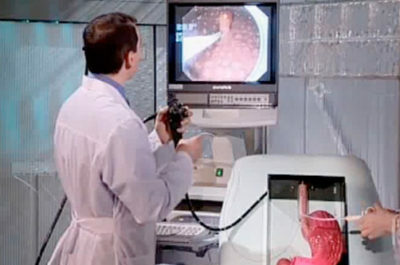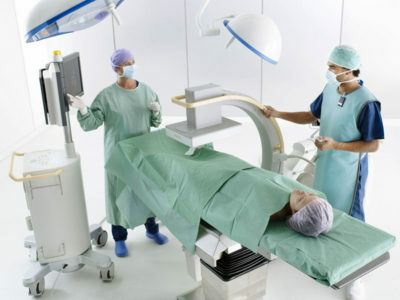1 The essence of multispiral computed tomography
Multispiral computed tomography of the abdominal cavity is a study in which X-rays pass through human tissues. This leads to images in various shades of gray, depending on the density of the tissue or the existing pathology. Its huge advantage is the ability to view organs shown almost as accurately as in an anatomical atlas.
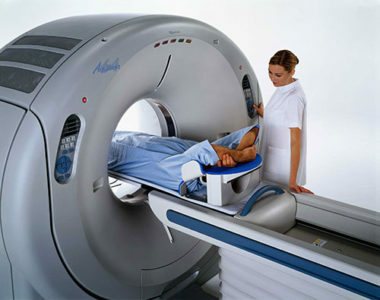
We recommend that you familiarize yourself with the

Preparing for the procedure of ultrasound of the abdominal cavity
Multispiral such a study is called because the radiator of X-moves along the annular line around the patient's body, but also moves in the direction of the longitudinal axis. X-ray tubes are located along the perimeter of the chamber, which resembles a tunnel, due to which the body layers are examined from different directions and at different angles.
If you draw the trajectory of the radiator during the entire procedure, the spiral leaves. Each of the turns of the spiral corresponds to a snapshot of one body zone in different angles. Pictures are called a slice. One cut may be 0.5 to 11 mm thick.
Computed tomography makes it possible to distinguish such composite abdominal cavities as the stomach, small and large intestine, and parenchymal organs such as the liver, spleen, kidneys, adrenals and pancreas. The tomogram also shows the biliary tract, and in special cases you can perform a cholangiography that reflects them more accurately.
Thanks to the ability to view several areas of the body in the shortest possible time, computed tomography of the digestive organs has become a frequently performed study. It is especially useful for diagnosing emergencies in hospital emergency departments: abdominal injuries or acute abdominal pain, as well tolerated by patients, and at the same time very effective.
Studies can be conducted with or without contrast agent administration( angiography). Angiography is useful in identifying the developmental defects of vascular diseases( birth defects), aneurysms and angiomas, stenosis of the renal artery. It happens that it is performed before the procedure of embolization - a targeted closure of the lumen of the vessel for treatment.
-
 IMPORTANT TO KNOW! Gastritis? Ulcer? To have a stomach ulcer not turned into cancer, drink a glass. ..Read the article & gt; & gt;
IMPORTANT TO KNOW! Gastritis? Ulcer? To have a stomach ulcer not turned into cancer, drink a glass. ..Read the article & gt; & gt;
2 Indications for
- Cancer of the intestines, stomach, pancreas, biliary tract, liver( for diagnosis and evaluation of the degree of development).
- Inflammatory bowel disease( Crohn's disease, nonspecific ulcerative colitis).
- Acute conditions, such as obstruction, perforation, appendicitis, colon diverticulitis, trauma.
- Injuries of the spleen.
- Gallstone disease.
- Acute and chronic pancreatitis( for differentiation and evaluation of complications).
- Inflammation of the kidneys. Calcification of the kidneys.
- Nephrolithiasis( sensitivity is almost 100%).
- Diseases of the kidney vessels.
- Cirrhosis of the liver.
- Badda-Chiari syndrome( ie, thrombosis of the veins of the liver or inferior vena cava).

3 Preparatory activities
The study is safe and painless for the patient, but some preparation is required before MSCT.Before the examination, the doctor will collect an anamnesis( sometimes you need to fill out a prepared questionnaire), you should report an allergy or an early reaction to the input of the contrast medium. To report it is necessary and about pregnancy, the period of lactation, claustrophobia, propensity to bleedings. It is worthwhile to deliver the results of other visualization methods.
-
 Gastroenterologist. IMPORTANT: "I beg you, if you started to worry about abdominal pain, heartburn, nausea, do not do gas in any way. .."Read more & gt; & gt;
Gastroenterologist. IMPORTANT: "I beg you, if you started to worry about abdominal pain, heartburn, nausea, do not do gas in any way. .."Read more & gt; & gt;
Before CT, the patient must remove all things from the metal. You should remove the mobile phone.
The patient should come to the MSCT examination of digestive organs on an empty stomach and after drinking a lot of liquid( 2-3 liters).It is important to have the actual result of the study of the level of creatinine.

Before scanning the small intestine, intravenously inject a contrast agent, for example diluted barite. It is a liquid substance that absorbs X-radiation to a greater or lesser extent than surrounding tissues.
In preparation for the procedure, it is necessary to observe the following rules:
- In order for the results of the diagnosis of the large intestine to turn out to be reliable, it is necessary to follow the diet( exclude milk, bread, cheese, fruits and vegetables) 2 days before the test and apply laxatives.
- The day before tomography, a liquid diet plus laxative is used, and on the day of the study an enema is performed. You can also introduce a relaxant to the patient( eg, hyoscine).
- In preparation for the study of the stomach, the patient drinks 750ml of water on an empty stomach immediately before the procedure to get the right contrast between the wall of the stomach and the surrounding structures.
- Before the study of the pancreas, 500-1500 ml of water is drunk approximately half an hour before computed tomography to fill the intestine.
ADVICE FROM THE MAIN GASTROENTEROLOGIST
Korotov SV: "I can recommend only one remedy for the rapid treatment of Ulcer and Gastritis, which is now recommended by the Ministry of Health. .." Read testimonials & gt; & gt;
In some cases, people who are not able to lie motionless during the study time, need to give sedatives, or even apply general anesthesia. In case of examination of children they are given a sedative, or general anesthesia is used. Before the investigation, the child should be informed of the progress of the MSCT procedure. He should know that computed tomography is a painless method that does not last long.
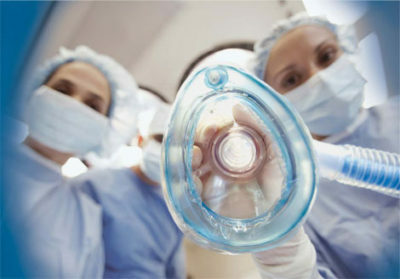
All questions concerning the preparation for tomography research should be discussed with your doctor in advance!
4 How is the diagnosis?
The study of multispiral computed tomography is carried out in a special laboratory, where the tomograph is located. The patient lies on his back on the table, which automatically moves. The investigated area of the body is installed in the area of action of X-ray lamps located along the circumference.
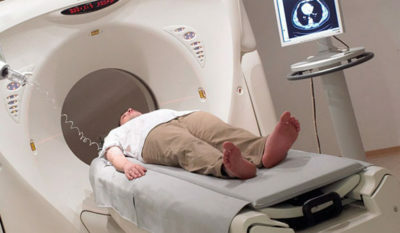
X-ray radiation, passing through various tissues of the patient's body, is weakened.
The degree of attenuation depends on the type of fabric. Images are obtained in the transverse plane, but it is also possible to carry out the appropriate reconstruction.
WE RECOMMEND!
For prevention and treatment of Digestive Diseases our readers advise Monastic tea. This unique remedy consists of 9 medicinal herbs useful for digestion, which not only complement, but also enhance each other's actions. Monastic tea will not only eliminate all symptoms of the gastrointestinal tract and digestive system, but will also permanently eliminate the cause of its occurrence.
Opinion of Doctors. .. »
During a CT scan, a doctor or technician is in an adjacent room and instructs the patient through the microphone about when he should lie still or hold his breath to improve the quality of the photographs, he follows the progress of the study. The patient must also report any anxiety symptom that occurs in his research: nausea, dizziness, dyspnea.
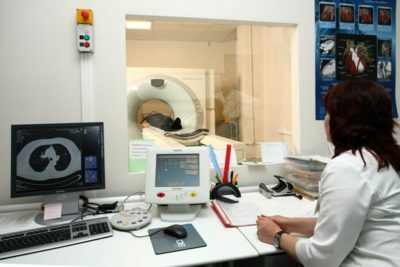
5 Possible complications of
Complications after MSCT can be associated, first of all, with the use of contrast medium, however this is very rare. Contraindications are:
- pregnancy;
- kidney failure;
- previously identified allergies to contrast agents.
Before the MSCT, one should always tell the doctor about chronic illnesses, such as diabetes mellitus( especially which is treated with pills).Computer tomography is a study that can be repeated several times, it can also be done for children.
Women should be avoided in the second half of the menstrual cycle, because they have the possibility of fertilization.
- 1 The essence of multispiral computed tomography
- 2 Indications for
- 3 Preparatory activities
- 4 How is the diagnosis carried out?
- 5 Possible complications of
One of the methods of visualizing the internal organs - MSCT of the abdominal cavity, what is it? Multispiral computed tomography is a type of diagnosis that uses X-rays to visualize internal organs. CT ideally reflects the central nervous system, chest and abdominal organs, osteoporosis. MSCT of the abdominal cavity is characterized by a high rate of data acquisition and processing. With the use of contrast agents, the study takes only half an hour.
Do you have gastritis?
GALINA SAVINA: "How easy is it to cure gastritis at home for 1 month. A proven method is to write down a recipe. ..!"Read more & gt; & gt;

